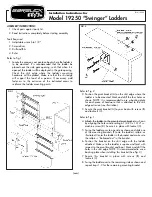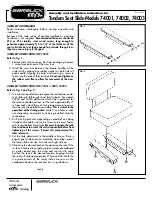
3.8.10.7.7
Power Factor 3 Element
The three element power factor transducer requires 3 voltages and 3 currents to test.
The MPRT will automatically select the first three voltages and currents channels
available,
V1, V2, V3
and
I1, I2, I3
. The test will initially start at the default values for
voltage and current that are set in the
Default Setting Screen
. For example, 120 Volts L-
N, 5 Amperes at their respective phase separations of 120 Degrees (note that for three
phase Power Factor transducers the transducer requires a balanced three-phase output).
The calculated Power Factors will be based on the phase separation between V1 and I1.
The Power factor transducer has a range of operation that correlates to the Leading or
Lagging phase angle relationship between the voltage and current inputs. Therefore,
when the user selects Power Factor 3 Element, the
MIN
and
MAX
nomenclature will
change to read
LEAD
(+) and
LAG
(-)
power factor values. The user is required to input
the
LEAD
and
LAG
power factor values into the provided spaces (normally the same
values, i. e. 0.5). The power factor is the trigonometric decimal equivalent value of the
COS of the angle between the V1 voltage and I1 current. For example, when the user
inputs the
LEAD
and
LAG
Power Factor values in the
Transducer Setting Screen
, the
firmware can calculate the required test angles for full scale values. Thus for a
LAG
Power Factor value of 0.5, the current would need to lag the voltage by 60
°
. The Lead
and Lag phase angles require that the vector display be changed to show angles as
±
180
°
. If the default angle representation is 0 to 360 LAG, then the angle between the
voltage and current will be considered lagging (current lags voltage). In this situation, the
typical test angles may vary between 0 to 90 degrees lag and 359.9 to 270 degrees lag
(90 degrees leading). This could cause some confusion to the user. By forcing the display
to
±
180
°
simplifies the testing considerably. The test will start at unity power factor, or
±
0
°
. Since the default angle will be 0
°
(zero degrees), the calculation is simple. The
formula required to calculate Power Factor is,
COS
∠
0
°
= 1.000 Power Factor (V1
∠
0
°
,I1
∠
0
°
)
Example: The default voltage is 120.00 Volts and current is 5 Amperes AC, and the user
inputs a Power Factor of
±
0.3 as
LEAD
and
LAG
Values. The angles required for full
scale output from the transducer is,
0.3 Power Factor = COS 72.5
°
or,
+
72.5
°
LEAD and -72.5
°
LAG
When the test is Started, the measured voltage and current outputs are displayed and the
calculated Power Factor is based on the measured phase angle bewteen the voltage and
current outputs. This is the value that gets displayed in the
Transducer Test Screen
under the
MPRT Output
, next to the Label of
Power Factor 3 Element
.
Another value of Power Factor gets calculated using the measured dc Volts or dc
milliampere output as displayed in the
Transducer Output
section. Let us assume that
in our next example transducer, the output is in dc milliamperes. For this example, let us
say that
±
1 milliampere of dc current is equal to the full scale Power Factor of
±
0.5.
Therefore, the theoretical range of output from the transducer would be - 0.5 Power
Factor, if the output current is -1 milliampere, to +0.5 Power Factor, if the output current
is +1 milliampere. For this example, let's say that the measured output voltage is 120.0
Volts, at 0
°
, and the measured output current is 5.000 Amperes, at a lagging angle of -
-
151
www
. ElectricalPartManuals
. com
















































